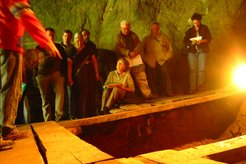New form of human discovered
Max Planck scientists decode the mitochondrial genome of a previously unknown hominin from the mountains of Central Asia
An international team of scientists from the Max Planck Institute for Evolutionary Anthropology in Leipzig has sequenced ancient mitochondrial DNA from a finger bone found in southern Siberia. The bone is from a previously unknown form of human that lived in the Altai Mountains of Central Asia around 48,000 to 30,000 years ago. This mitochondrial genetic material, passed down through the descendants in the maternal line, is a sign of a new wave of migration out of Africa, one that is distinct from that of Homo erectus, the ancestors of Neanderthals and Homo sapiens (Nature, 24 March 2010).

The first group of hominins to leave Africa some 1.9 million years ago was Homo erectus. Archaeological finds and genetic data indicate that at least two other groups left Africa at a later date: first, around 500,000 to 300,000 years ago, the ancestors of the Neanderthals migrated. Then, about 50,000 years ago, it was the turn of the forefathers of anatomically modern humans. Direct descendants of Homo erectus may have survived in Indonesia until less than 100,000 years ago. Older representatives of Homo erectus and Homo heidelbergensis also lived in more northerly climes, for instance in the Altai Mountains in southern Siberia more than 125,000 years ago. Neanderthals also lived in Siberia at that time.
Johannes Krause, Svante Pääbo and their colleagues from the Max Planck Institute for Evolutionary Anthropology in Leipzig have now sequenced mitochondrial DNA from a tiny fragment of a finger bone. The bone was found in the Denisova Cave in the Altai Mountains in southern Siberia in 2008. The scientists compared the ancient DNA from the mitochondria, the "powerhouses of the cell", with the mitochondrial DNA of Neanderthals and of humans alive today. They found that the mitochondrial DNA of this hominin from southern Siberia differed markedly from all other known hominins.
A detailed analysis of the mitochondrial genetic material showed that this hominin shared a descendant with modern humans and with Neanderthals about 1.0 million years ago. This common descendant is about twice as old as the shared descendant of anatomically modern humans and Neanderthals, as determined on the basis of their mitochondrial DNA. Furthermore, the age of the fossil indicates that this unknown form of human could have co-existed with Neanderthals and modern humans in southern Siberia.












